The Topkapi Scroll, the best preserved example of its kind, contains
far-reaching implications for the theory and praxis of geometric design
in Islamic architecture and ornament. Created by master builders
in the late medieval Iranian world, the scroll compiles a rich repertory of
geometric drawings for wall surfaces and vaults. This important document
belongs to a once-widespread Islamic tradition of scrolls in which geometric
patterns ranging from ground plans and vault projections to epigraphic
panels and architectural ornament in diverse media appeared side by side.
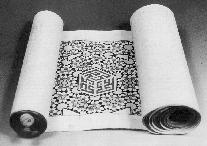
|
Topkapi Scroll
Late 15th or early 16th century. Ink and colors on paper.
|
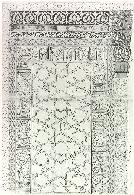
|
Schematic design for a cast metalwork door with star-and-polygon patterns
Ismail b. al-Razzaz al-Jazari. From his "Kitab fi marifat al-hayat al-handasiya" (book on the knowledge of ingenious mechanical devices), Diyarbakir, 1206, watercolor and ink on paper, MS A.3472, Fols. 165v-166r.
|
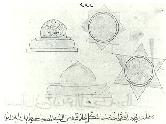
|
Diagrams showing the details for the individual units of a cast metalwork door with star and polygon patterns
Ismail b. al-Razzaz al-Jazari. From his "Kitab fi marifat al-hayat al-handasiya" (book on the knowledge of ingenious mechanical devices), Diyarbakir, 1206, watercolor and ink on paper, MS A.3472, Fols. 167v.
|
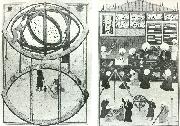
|
Taqi al-Din b. Maruf and his collegues at the Istanbul observatory
Miniature painting. From Lokman, Shahanshahnama (book of the king of kings), Istanbul, 1581-1582.
|
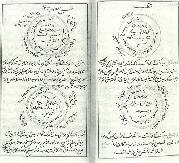
|
Diagrams of metric circles representing rythmic patterns of sound
Muslih al-Din Mustafa Sururi. From his "Bahr el-maarif" (Sea of knowledge),
written for the Ottoman prince Mustafa in 1549, copied in 1585, red and
black ink on paper. MS H. 659, Fols. 17v-18r.
|
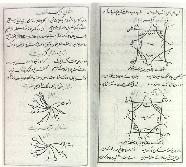
|
Diagrams of pattern-forming verses
Muslih al-Din Mustafa Sururi. From his "Bahr el-maarif" (Sea of knowledge),
written for the Ottoman prince Mustafa in 1549, copied in 1585, red and
black ink on paper. MS H. 659, Fols. 134v-135r.
|
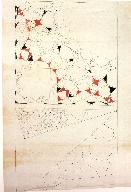
|
Vault fragment with black-dotted polygonal grid lines, triangular one-twentieth repeat unit of a decagonal vault, and fan-shaped radial muqarnas quarter vault.
|
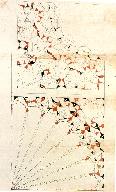
|
Fan-shaped radial muqarnas quarter vault, and shell-shaped radial muqarnas quarter vault.
|
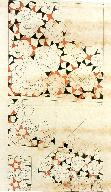
|
Fan-shaped radial muqarnas quarter vault, rhombodial one-eight repeat unit of an octagonal fan-shaped radial muqarnas quarter vault, fan-shaped radial muqarnas quarter vault, and rectangular repeat unit of stellate muqarnas fragment.
|
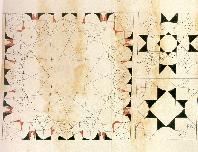
|
Fan-shaped muqarnas full vault, stellate muqarnas full vault, and another stellate muqarnas full vault.
|
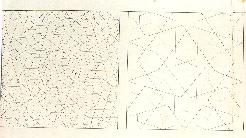
|
Quarter repeat unit of a star-and-polygon pattern with two superimposed layers, and quarter repeat unit of a pattern with two superimposed layers.
|
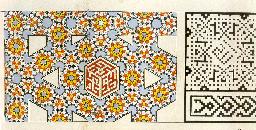
|
Repeat unit of a fragmentary square panel, and quarter repeat unit of a double-layered pattern for relief mosaic tile work.
|
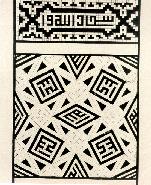
|
Linear repeat unit of a square kufic inscription, and repeat unit composed of rotated squares and rhombuses with kufic kalligraphy.
|
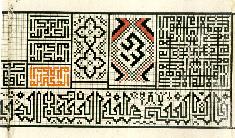
|
Strip of a naskhi inscription, square kufic calligraphic panels, linear repeta unit of square kufic inscriptions, and linear repeat unit of geometric patterns.
|
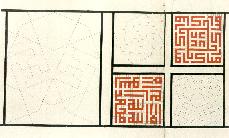
|
Quarter repeat unit of star-and-polygon patterns, and quarter repeat units of kufic calligraphic panels.
|
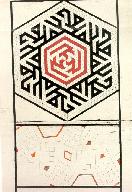
|
Quarter repeat unit of a pattern with swastika motifs, and hexagonal panel with kufic inscriptions.
|
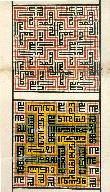
|
Composite square kufic calligraphic panels.
|
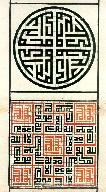
|
Square kufic calligraphic roundel, and composite square kufic calligraphic panel.
|

|
Hexagonal calligraphic panel with kufic letters, stellate arch-net quarter vault, and fan-shaped radial muqarnas quarter vault.
|
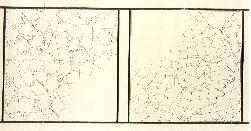
|
Fan-shaped radial muqarnas quarter vaults
|